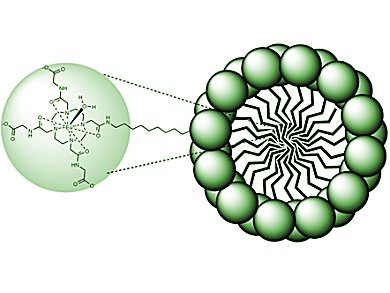Magnetic resonance imaging (MRI) has evolved into one of the most powerful non-invasive techniques in diagnostic medicine. Abnormal growth such as tumors can be made visible by conventional gadolinium-based contrast agents.
Chemical exchange saturation transfer (CEST) agents are an emerging class of contrast media that can alter image contrast by decreasing the total bulk water signal intensity. They can provide clues as to the distribution of acidity, which is important in cancer research, or the amount of glucose overproduction, vital for diabetics, or oxidative stress in the body.
In a typical CEST experiment, the resonance of the labile protons of the CEST agent may be selectively saturated by using a specific radiofrequency pulse. Saturated magnetization is then transferred from the labile protons to the bulk water protons through a chemical exchange process that has to be maintained within the slow-to-intermediate regime. This translates into a negative contrast in an MR image.
Certain paramagnetic lanthanide complexes with tetraazacyclododecanetraacetic acid (DOTA)-tetraamide ligands induce large hyperfine shifts in the bound water protons and other nearby exchanging protons in the chelating ligand. This discovery has led to the development of a new class of CEST agents referred to as paramagnetic chemical exchange saturation transfer (PARACEST) agents.
Dean Sherry, University of Texas, Dallas, USA, and co-workers, prepared four new DOTA-tetraamide ligands having variable alkyl chain lengths (C1, C12, C14, and C16) and their respective europium(III) complexes. The three EuL complexes with the longest alkyl chains spontaneously formed micelles of variable size. CEST experiments showed that all four EuIII complexes display slow-to-intermediate water exchange kinetics.
These features highlight the potential of using micelle-based systems such as these as PARACEST agents for molecular imaging by MRI.
- Amphiphilic EuDOTA-Tetraamide Complexes Form Micelles with Enhanced CEST Sensitivity,
Osasere M. Evbuomwan, Garry Kiefer, A. Dean Sherry,
Eur. J. Inorg. Chem. 2012.
DOI: 10.1002/ejic.201101369
More articles in the field of MRI imaging can be found in the EurJIC cluster issue on Metal-Based MRI Probes.




